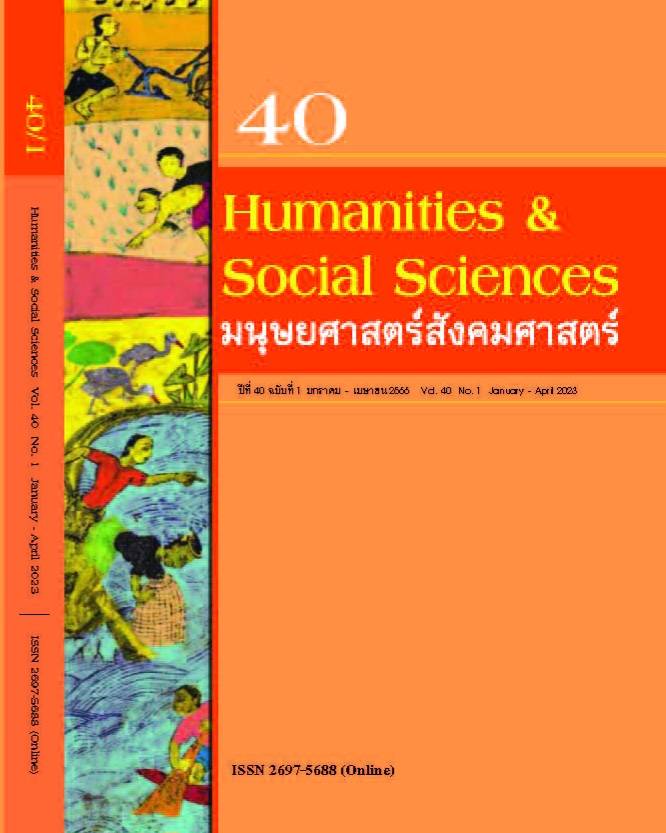CLIL Teachers Training Needs: Myanmar Upper Secondary School Biology Teachers’ Voices
Keywords:
Keywords: Content and Language Integrated Learning (CLIL), Needs Analysis (NA), Upper Secondary School Teacher Training in MyanmarAbstract
Abstract
This qualitative study investigated the needs of school teachers teaching biology subjects at the upper-secondary level in Myanmar for the CLIL teacher training. Semi-structured interview was conducted through the online interview asking four upper secondary biology teachers about their 1) current teaching practices, 2) problems in the current teaching, and 3) needs in CLIL teacher training. Findings revealed that in terms of their current teaching practices, most teachers used the teaching methods that facilitate students' knowledge gaining. In revealing teachers' problems, data indicated that they encountered difficulties in areas of teaching methodology, content knowledge, English language for communication, thinking skills, learning activities, assessment, and classroom management. In terms of teachers' needs, the four teachers wanted the training course to develop their 1) skills and knowledge in CLIL teaching, 2) linguistic knowledge necessary for their teaching content, 3) overall language knowledge and skills, and 4) knowledge of how to manage activities to help their students learn successfully.
Keywords: Content and Language Integrated Learning (CLIL), Needs Analysis (NA), teacher training, upper secondary school teachers in Myanmar
References
References
Bertaux, P., Coonan, C.M., Frigolos-Martin, M.J., & Mehisto, P. (2010). The CLIL teacher competences grid. CLIL Cascade Network. Retrieved January 20, 2023, from http://tplusm.net/CLIL_Competences_Grid_31.12.09.pdf.
Bloom, B.S.L. (1956). Taxonomy of Educational Objectives, Handbook I: The Cognitive Domain. New York: David McKay.
British Council. (2014). English for Education College Trainers (EffECT Handbook). Myanmar: British Council.
Brown, J. D. (2016). Introducing Needs Analysis and English for Specific Purposes. New York: Routledge.
Chostelidou, D., & Griva, E. (2013). Measuring the effect of implementing CLIL in higher education. An experimental research project. Procedia – Social and Behavioral Sciences, 166, 2169-2174. Retrieved December 15, 2022, from https://doi.org/10.1016/j.sbspro.2014.12.611.
Coyle, D. (2007). Content and language integrated learning: Towards a connected research agenda for CLIL pedagogies. The International Journal of Bilingual Education and Bilingualism, 10, 543-562.
Dafouz, E., Nuñez, B., Sancho, C. & Foran, D. (2007). Integrating CLIL at the tertiary level: Teachers’ and students’ reactions. In Marsh, D. & Wolff, D. (eds.) Diverse contexts – converging goals: CLIL in Europe (pp. 91-102). Frankfurt: Peter Lang.
Dale, L., and Tanner, L. (2012). CLIL Activities: A Resource for Subject and Language Teachers. Cambridge: Cambridge University Press.
European Union. (2015). Erasmus+ programme. Europe: EU publications.
Evans, S. and John, St. (2009). The medium of instruction in Hong Kong revisited: Policy and practice in the reformed Chinese and English streams. Research Papers in Education, 24(3), 287-309.
Hyland, K., and Shaw, P. (2016). The Routledge Handbook of English for Academic Purposes. New York: Routledge.
Johns, A. (1991). English for specific purposes: Its History and Contribution. In M. Celce-Murcia (Ed.), Teaching English as a Second or Foreign Language (pp. 67-77). Boston, MA: Heinle and Heinle Publishers.
Khalyapina, L. (Ed.). (2020). Examining Content and Language Integrated Learning (CLIL) Theories and Practices. Pennsylvania: IGI Global.
Lesca, U. (2012). An Introduction to CLIL. London: British Study Center.
Marsh, D. (2000). An introduction to CLIL for parents and young people. Using languages to learn and learning to use languages. Jyvaskyla: University of Jyvaskyla.
Mazher, U., Ahmed, M., & Aslam, M. (2015). Grammar Translation Method in ELT: Hindering the development of communicative skills at secondary level. Journal of literature, languages, and linguistics, 6(1), 65-72.
Mehisto, P. et al. (2008). Uncovering CLIL: Content and Language Integrated Learning in Bilingual and Multilingual Education. Macmillan, Oxford.
Ministry of Education. (2004). Development of Education in Myanmar. Myanmar: Ministry of Education.
Myint, M. (1992). The teaching of English. Ministry of Education/ UNDP/ UNESCO Education Sector Study Project: Working Paper Series. Myanmar: Myanmar Education Research Bureau.
Pérez Cañado, M. L. (2014). Teacher Training Needs for Bilingual Education: In-service Teacher Perception. International Journal of Bilingual Education and Bilingualism, 19(3):266-95.
Pérez Cañado, M. L. (2018). Innovations and Challenges in CLIL Teacher Training. Theory Into Practice, 57(3), 212-22.
Soe, T., Ko, T. and Myint, S. (2020). Attitudes towards English as a medium of instruction (EMI): a case study of University of Mandalay. University of Mandalay Research Journal, 11, 108-115.
Suwannoppharat, K., and Chinokul, S. (2015). Applying CLIL to English language teaching in Thailand: Issues and challenges. Latin American Journal of Content & Language Integrated Learning, 8(2), 237-254.
Ulla, M. B. (2017). Teacher training in Myanmar: teachers’ perceptions and implications. International Journal of Instruction, 10(2), 103–118.
VandeCraen, P. (2007). Cognitive development and bilingualism in primary schools: teaching maths in a CLIL environment. In D. Marsh and D. Wolff (Eds.), Diverse Contexts – Converging Goals. (185–200). Frankfurt am Main: Peter Lang.
Weil, C. (2013). The current political and higher education context in Myanmar. In Institute of International Education (Ed.), Investing in the future: rebuilding higher education in Myanmar (pp. 12-16). New York: A briefing paper from IIE’s center for international partnerships.
West, R. (1994). Needs Analysis in Language Teaching. Journal of Language Teaching, 21 (1), 1-19.



